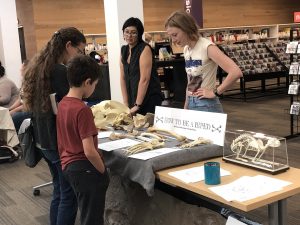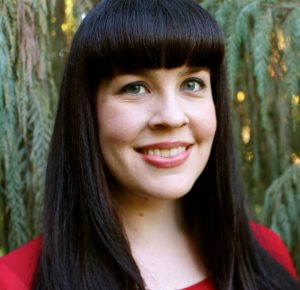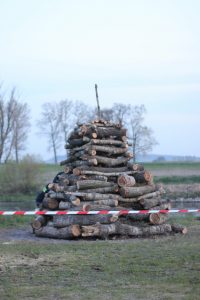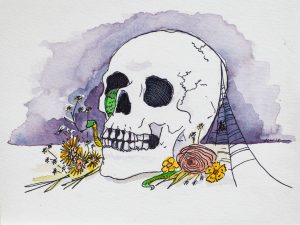There have been moments in my life when my freezer has been stuffed to the brim with songbirds, bobcats, opossums, armadillos, frogs, and racoons. Once, on a first date, I changed the evening plans to include grabbing a dead coyote I’d spotted on the side of the road. It was in perfect condition and too good of an opportunity to pass up. Needless to say, that relationship ran its course.
I have spent a lot of my life curious about bones of the human and non-human sort. I unearthed mammoths, mastodons, and giant ground sloths, repelled into caves in search of ancient salamanders, and spent time in universities and on the coasts of Alaska studying ivory, antler, and whale bone. Because of these curiosities, I’ve run home experiments to better understand rates of decomposition, strength and flexibility of different bones, and the locomotion of different kinds of animals. Hence the freezer full of animals.
Over time, I’ve learned (and unlearned, then relearned) not to advertise my interest in death. I suppose this blog post is me unlearning that. Again.
What sparked this most recent unlearning event? A few weeks back, I heard an interview with Caitlin Doughty on NPR about her latest book, Will My Cat Eat My Eyeballs?. I was smitten and got my hands on a copy.
Although it is an inevitable part of living, death and conversations about what physically happens to our bodies when we die is a taboo topic in much of the Western world. Caitlin tackles a topic that can be unsettling by responding to questions posed by children, setting the stage for this book to be brutally honest, hilarious, and simultaneously sensitive to the pain we feel when someone we love dies.
For at least two reasons she sticks to the, politely put, more grotesque aspects of death and doesn’t attempt to delve into spirituality. First, Caitlin is a professional mortician, not a spiritual leader. Second, perhaps somewhat surprising to the reader, kids don’t tend to ask questions about if there’s a heaven that we go to when we die.
Kids want to know if we fart when we die. They are curious about what the body of their deceased pet gerbil, resting peacefully in their backyard, will look like if they dig it up. They want to know what will happen if you accidentally eat unpopped popcorn kernels before you die and then you are cremated- which, by the way, is an excellent question that has an even more entertaining response from Caitlin. And Doughty, with her wit, scientific explanations, and empathy is the perfect resource to respond.
This book is full of answers to the questions adults are afraid to ask because they might make us seem morbid. Kids don’t care. They are uninhibited by social norms.
In her previous book, From Here to Eternity, Caitlin delves into the cultural and social norms of death practices. Providing a good dose of cultural relativity, Doughty points out that any ritual around death is not inherently wrong. Rituals are important in the grieving process. Since at least the days of the Neanderthals, we have practiced specific ritual behaviors associated with death. Sometimes these practices are seen as burials. Sometimes people use pyres and other means of burning the deceased. And, yes, in some cultures cannibalism is a perfectly healthy and normal practice for honoring those who have passed.
Yet the American funeral industry has commodified death. Increasingly since the Civil War, our society has convinced mourning and grieving loved ones that the process of celebrating and honoring the life of the deceased should include marble headstones, embalming fluids, vaults, expensive caskets, and other rituals that detach us from the physicality of death. Doughty suggests that this economy around death culture is not only harmful to the environment, but it also creates a sense of detachment for the mourner in an already vulnerable and isolated time.
Regardless of these rituals, when we stop living our bodies don’t just magically disappear. Since it is inevitable that death will happen to all of us and everyone we know, aren’t you even just the slightest bit curious if you were to die “making a stupid face” it’ll be stuck like that forever?
Caitlin Doughty is passionate about challenging us to talk openly about death and create a culture of death positivity. Her latest approach of incorporating the curiosities of her youngest audiences into this challenge is truly delightful and a great place to start if you’re a death curious oddball.
Here’s to a coupla C(K)aitlin’s hoping that one day, with enough conversation with kiddos and adults alike, we can leave off the oddball part of that description.
Interested in local death and burial resources?
- Death Colloquy is a Lawrence and Kansas City resource for learning about natural burials, home funerals, death doulas and other death positive resources.
- Oak Hill Cemetery has a natural burial section. More information about this resource can be found through the City of Lawrence.
- Burial laws specific to Douglas County and Kansas can be found here.
-Kaitlin Stanley is a Readers' Services Assistant at Lawrence Public Library







Add a comment to: Overcoming the Fear of Death: How Conversation, Popcorn, and Curious Children Can Help